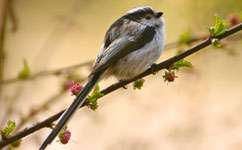Long-tailed tits help each other out

Long-tailed tits which lose their eggs or young may help to feed neighbours' chicks, researchers have found. But the degree to which they'll co-operate varies from year to year.
A study by UK researchers shows that the extent of helping depends on two factors: the number of nests attacked by predators, and the length of the breeding season, which determines whether or not failed breeders can re-nest.
Co-operation among animals is a long-standing puzzle for scientists. 'It appears to contradict Darwin's theory of natural selection,' explains Professor Ben Hatchwell from the University of Sheffield, lead author of the study, 'which leads us to expect that individuals should try to maximise their own breeding success rather than helping others.'
Yet co-operation is quite common in nature. Around nine per cent of bird species show some form of co-operative breeding. The most common pattern is that groups form through 'delayed dispersal', where the young stay with their parents and help to feed the next generation of chicks, before eventually going off to breed on their own after a few years. There can be direct benefits from this type of helping, such as learning how to be a good parent, or receiving reciprocal help in the future.
But long-tailed tits are unusual - they all try to breed at first, and it's only if they fail that they may help out at another nest. Scientists call this 're-directed helping'.
Over 70 per cent of nests fail, usually because magpies, weasels and other predators steal the eggs or young. Birds may nest again if they have time, otherwise they often become helpers at a nearby nest, with 73 per cent choosing to help a close relative; usually a sibling. Around 85 per cent of helpers are male; females are less likely to have relatives nearby because they disperse further from home in their first winter.
The researchers observed a population of about 120 long-tailed tits in the Rivelin valley near Sheffield. Between 1995 and 2011, the number of helpers varied from five to 27 per cent of the population.
The study found that helping is related to the rate of attack by nest predators, but not through a simple linear relationship. If no nests are attacked, there are no failed breeders, and if all nests are lost, there are no opportunities to help, so helping peaks at medium levels of predator attack. The other main factor is the length of the breeding season, which varies with weather conditions. There are more helpers in shorter breeding seasons, when opportunities for failed breeders to re-nest are limited.
The helpers do not gain any direct rewards, but they increase the survival of their relatives, so that more of their genes enter the breeding population in the following season. 'If you offer the birds a choice between helping a relative and a non-relative, at the same distance, they almost always choose the relative's nest,' explains Hatchwell. 'They also work harder if they are more closely related to the brood. There is no evidence that helpers have a higher reproductive success in future, so they are probably not getting reciprocal help, or any other direct benefit.'
To cooperate or not to cooperate?
The study sheds light on the factors driving co-operation in long-tailed tits, and will feed into on-going research into why some species co-operate and others don't.
'The importance of co-operation is apparent at pretty much every level of biological organisation,' says Hatchwell, 'including the transition from unicellular organisms to multicellular organisms, which is an expression of co-operation among cells. Some cells become sterile and help others to reproduce. The same in social insects where you have a single reproductive queen and lots of sterile workers who are all helping her to reproduce.'
The 20-year Rivelin Valley project is one of a relatively small number of long-term studies of a single population of birds. 'Long-term data opens up lots of opportunities to ask interesting questions,' says Hatchwell. 'As time goes by, the number of issues you can address goes up exponentially. For example, we now have enough data to look at the effects of climate change on long-tailed tits.'
Can this teach us anything about co-operation in human societies? 'Anything that helps us to understand co-operation in human societies would be very beneficial,' says Hatchwell, 'because we're not very good at it in many respects. Some of the major problems we face, such as climate change, require co-operation at a higher social level through international agreements.'
There's a downside to cooperation – free-riders. 'There's always the temptation for some individuals to take benefits of co-operation but not pay the costs, leading to problems such as over-exploitation,' Hatchwell concludes.
More information: Hatchwell, B. et al. Ecological and demographic correlates of helping behaviour in a cooperatively breeding bird, Journal of Animal Ecology 2013, 82, 486-494
Journal information: Journal of Animal Ecology
Provided by PlanetEarth Online
This story is republished courtesy of Planet Earth online, a free, companion website to the award-winning magazine Planet Earth published and funded by the Natural Environment Research Council (NERC).





















